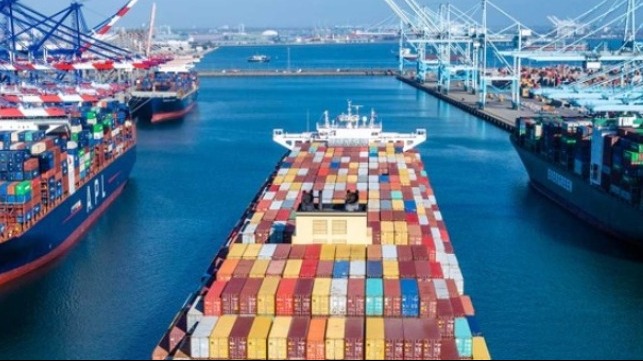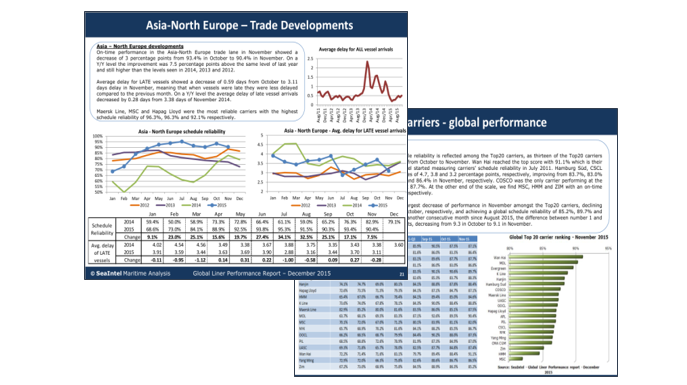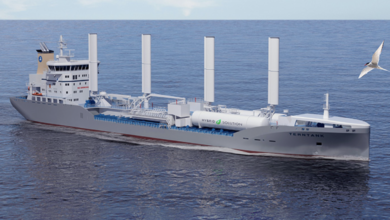Sea-intelligence : Continued Transpacific vessel pressure

EcSIn issue 551 of the Sunday Spotlight, we looked at one of many elements causing congestion issues in ports around the world: the number of deployed vessels.
In very simplified terms, it is less efficient to handle two 5,000 TEU vessels than it is to handle one 10,000 TEU vessel, once the time to get to and from berth is factored in. A change in the number of vessels will therefore be an element feeding into the congestion issues. To analyze this particular aspect, we used data from our Trade Capacity Outlook database.

During the early pandemic period, there was an unusually large decline in the number of deployed vessels as blank sailings rose rapidly. But after this early phase, the number of deployed vessels first increased back to normal, and then reached a high point towards the end of peak season 2021. There was a temporary drop for Chinese New Year 2022, followed by a very sharp upwards correction as we get into the current outlook for March/April 2022.

To better view the changes, figure 1 shows the change in the number of vessels since the start of 2020, relative to the pre-pandemic period (2017-2019). With the recent data, we can see a seasonal dip due to Chinese New Year 2022, but it is the increase in March/April 2022 that should be particularly noticed. The number of vessels scheduled to depart Asia – and subsequently arrive on the North American West Coast – will increase sharply and surpass a 40% increase compared to the pre-pandemic normality. This in itself will add further pressure on the port infrastructure.
What is more alarming is that there is a 60% increase in the number of vessels on the Asia-North America East Coast trade lane in the coming months, as carriers try to circumnavigate port congestion on the West Coast. This will severely increase pressure on the port infrastructure on the East Coast.
— 000 — END OF PRESS RELEASE — 000 —
All quotes can be attributed to Alan Murphy, CEO, Sea-Intelligence.
For more information, please contact: [email protected], [email protected]

Monthly Report on Schedule Reliability in Container Shipping
The industry’s by far most comprehensive study of ocean liner schedule reliability, measuring schedule reliability and vessel delays across all deep-sea liner services, based on more than 12.000 vessel arrivals, and measures and benchmarks the schedule reliability performance of 60+ container carriers in 34 different trade lanes, across more than 300 liner services/loops. The GLP report is published as a 116-page PDF report at the end of each month and comes with a complimentary Excel data-file report with all the data from the report.
- 12,000 Monthly Vessel Arrivals
- 60+ Container Carriers
- 34 different Tradelines
- More than 300 Services/loops
Subscriptions start at 2,000 Euro/Year for 12 monthly issues, with unrestricted sharing within the subscribing company. Contact [email protected] to start a subscription.

Weekly Analytical Report on the Container Shipping Industry
The leading weekly analytical report covering the container shipping industry. Published every Sunday evening, it features three main independent analytical articles, covering all major drivers of container shipping, e.g. macroeconomics, Supply/Demand, freight rate developments, performance metrics, volume developments, transit times, deployment, etc. The Sunday Spotlight also contains an editorial discussing major market developments, and a standard overview of carrier service changes, and all posted General Rate Increases.
- Leading Analytical, Industry Report
- Covering all major Drivers
- Published every Sunday
Subscriptions start at 1,800 Euro/Year for 52 weekly issues, with unrestricted sharing within the subscribing company. Contact [email protected] to start a subscription.
Weekly Report on Trade Capacity Deployment and Outlook
The industry’s only forward-looking capacity deployment report, based on actually named vessel schedules. The report is published every Friday and provides data on week-by-week capacity deployment in the World’s 19 major container trade lanes. The TCO report provides both a historical Y/Y perspective on deployed capacity, as well as forward-looking data on variations in deployed capacity figures. As Sea‑ tracks all vessels deployed on all container services in the major trade lanes each week, we can provide an exclusive overview of the exact capacity to be deployed in the coming 12 weeks, based on the vessel schedules issued by carriers.
- Week-by-week capacity
- Covering 19 major trade lanes
- Exact Capacity to be deployed in the coming 12 weeks
- Published every Friday
Subscriptions start at 2,200 Euro/Year for 52 weekly issues, with unrestricted sharing within the subscribing company. Contact [email protected] to start a subscription.
Custom
Data Services
Schedule reliability and vessel delays, across pretty much any conceivable scope, be that trade lane, port-pair, port/region in-/outbound, and across carriers, services, carrier roles, and any time period since January 2012.
Global and Trade weekly capacity supply, vessel deployment, blank sailings, extra-loaders, vessel operators, capacity market shares of alliances/operators, etc., across all deep-sea services from January 2012 and 3 months into the future.
Data on service deployment, Alliances, Vessel Sharing Agreements (VSAs), slot charters, offered direct port-pairs, service frequency, transit times, port rotations, carrier roles, the port stays, time-at-sea, etc. across all deep-sea services from January 2012 and 3 months into the future.
Container Vessel operational, deployment, and particulars data, on vessel operators, service deployment and phase-in/-out, vessel design (nominal intake, LxBxD, reefer slots, active and design draft, etc.), flag registry, owner history, etc. for all container and container-capable vessel deployed on deep-sea liner services since January 2012.














